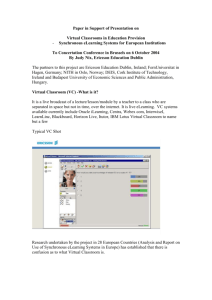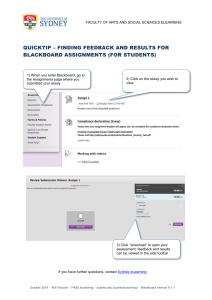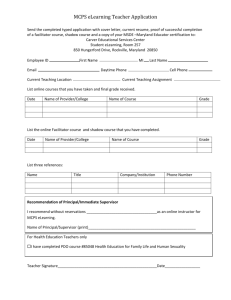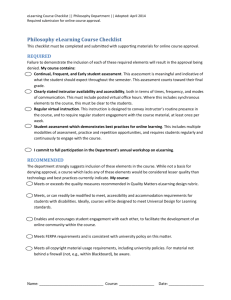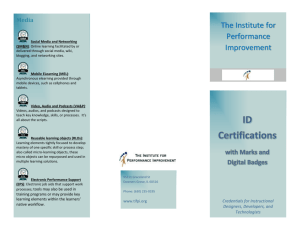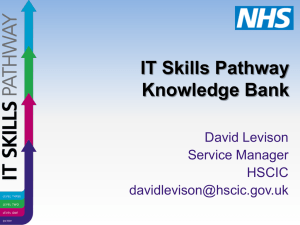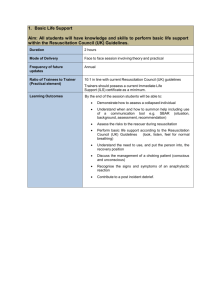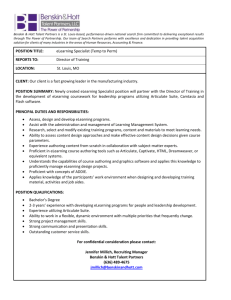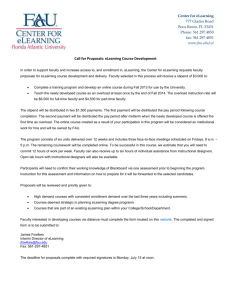elearning - Learning Services
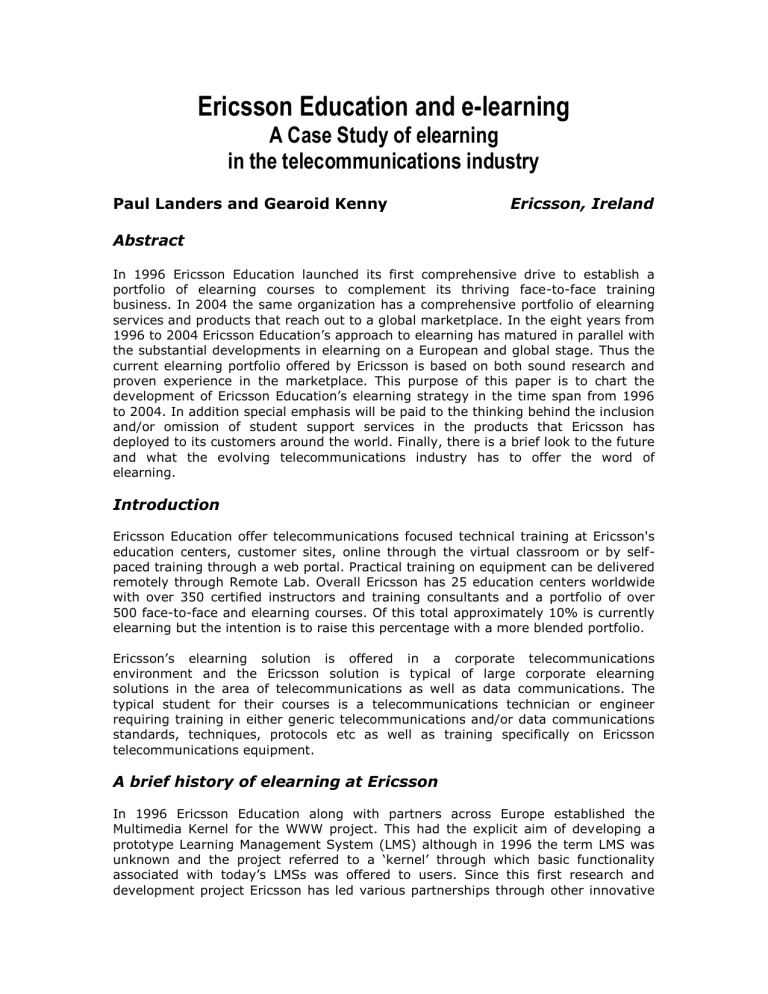
Ericsson Education and e-learning
A Case Study of elearning in the telecommunications industry
Paul Landers and Gearoid Kenny
Abstract
Ericsson, Ireland
In 1996 Ericsson Education launched its first comprehensive drive to establish a portfolio of elearning courses to complement its thriving face-to-face training business. In 2004 the same organization has a comprehensive portfolio of elearning services and products that reach out to a global marketplace. In the eight years from
1996 to 2004 Ericsson Education’s approach to elearning has matured in parallel with the substantial developments in elearning on a European and global stage. Thus the current elearning portfolio offered by Ericsson is based on both sound research and proven experience in the marketplace. This purpose of this paper is to chart the development of Ericsson Education’s elearning strategy in the time span from 1996 to 2004. In addition special emphasis will be paid to the thinking behind the inclusion and/or omission of student support services in the products that Ericsson has deployed to its customers around the world. Finally, there is a brief look to the future and what the evolving telecommunications industry has to offer the word of elearning.
Introduction
Ericsson Education offer telecommunications focused technical training at Ericsson's education centers, customer sites, online through the virtual classroom or by selfpaced training through a web portal. Practical training on equipment can be delivered remotely through Remote Lab. Overall Ericsson has 25 education centers worldwide with over 350 certified instructors and training consultants and a portfolio of over
500 face-to-face and elearning courses. Of this total approximately 10% is currently elearning but the intention is to raise this percentage with a more blended portfolio.
Ericsson’s elearning solution is offered in a corporate telecommunications environment and the Ericsson solution is typical of large corporate elearning solutions in the area of telecommunications as well as data communications. The typical student for their courses is a telecommunications technician or engineer requiring training in either generic telecommunications and/or data communications standards, techniques, protocols etc as well as training specifically on Ericsson telecommunications equipment.
A brief history of elearning at Ericsson
In 1996 Ericsson Education along with partners across Europe established the
Multimedia Kernel for the WWW project. This had the explicit aim of developing a prototype Learning Management System (LMS) although in 1996 the term LMS was unknown and the project referred to a ‘kernel’ through which basic functionality associated with today’s LMSs was offered to users. Since this first research and development project Ericsson has led various partnerships through other innovative
project in the area of elearning. For example in 2000 a consortium was formed involving Roma Tre, FernUniversitat, NKI, DEI and Ericsson. The partnership secured funding under the Leonardo programme for an ambitious pilot project that looked at the possibility of using mobile devices (telephones, smartphones, PDAs) for learning purposes. The results were presented at a very successful conference in Dublin in
Autumn 2002. Ericsson is continuing research today in the field of mlearning and a follow-up conference is planned for Autumn 2005.
In parallel with the first EU funded project in 1996 Ericsson formed an in-house group of experts based in Dublin who developed elearning content mostly in CD-ROM format. This group still exists in the training center in Dublin today but the emphasis has shifted significantly from content production to content deployment and related services. There are a number of reasons for this but it has proven to be more cost effective to out-source content development to specialist elearning companies leaving Ericsson to concentrate on servicing the deployment of this content across the many web portals that Ericsson operates today as well as across the many LMSs that our customers utilize.
Ericsson’s position today is that we recommend that our eLearning products be used as part of a Blended Learning solution, which is the term applied to a learning solution that combines a number of different types of learning products. A typical
Blended Learning Solution might combine Instructor Led Training (ILT) with Web,
Multimedia and Virtual Classroom based training products to produce a Blended solution, designed to achieve pre-defined goals and objectives of the participants.
Blended Learning Solutions offer many advantages to their students when compared with solutions involving only a single training medium. The advantages arise principally because the students can use eLearning to supplement their learning activities, either prior or subsequent to, attending ILT so that the material is better understood and retained for longer. A browse through Ericsson’s online catalogue today reveals a wide variety of delivery media (streaming video, electronic articles, web-based learning courses, etc) covering a wide variety of telecommunications topics (WCDMA, GPRS, GSM etc). Please refer to this website for details: http://learning.ericsson.net/eeonline/index.shtml
One of the recent success stories in the area of elearning has been Virtual Classroom
Training.
Virtual Classroom Training (VCT)
This is a relatively new branch of elearning and Ericsson has had a presence of virtual classroom training courses in its portfolio for the past 18 months. This has been mirrored by developments outside Ericsson in the general telecommunications industry. The recent growth of VCT has been greatly facilitated by the availability of powerful software applications such as Centra and Interwise that allow for tutors and teachers to meet in a virtual classroom where they are separated by space but not by time. Virtual Classroom Training bridges the gap between elearning and face-toface learning and in Ericsson’s experience has introduced a new enthusiasm for the potential of elearning. VCT is generally perceived as a great cost and time saver as students can sit at their own desks but still participate in a live training experience with a real tutor. Savings are made in both travel expenses and time lost away from the office in transit to and from the training event.
Student Support Services in elearning
The Ericsson Education Online solution and associated training courses were analysed in terms of how they support each of the elearning phases defined in the evaluation matrix produced during output 2 of the project ‘Student Support Services in eLearning’. This matrix had 4 main phases; Information, Guidance/Registration,
Integration/Help Desk and the Learning Phase.
The analysis was done in terms of both the “generic” EEOnline site (the Internet site available to all users and potential users, see http://learning.ericsson.net/eeonline/ ) and “Customer systems”, that is, portal solutions sold to corporate customers.
Customer systems are largely similar to the generic site, but typically include a more comprehensive / tailored implementation of the various functionality and applications available on the generic site. As such there are inherent differences when compared to academic elearning solutions and this is apparent when student support services are analysed and discussed in this paper.
Information Phase
The principal activities conducted during this pre-registration phase are an exploration and examination of the available student material via an examination of the material issued in support of the eLearning courseware.
Both the generic and customer systems support the following components of the
Information phase:
Information relating to the course
Information relating to the program to which the course belongs.
Vendor contact capability
FAQ section
Information relating to the course:
Students can access five types of online courses via our sites. These are briefly introduced below and are covered in more detail in the section covering the Learning
Phase:
Web Based Learning (WBL) - courses hosted on an Internet server and delivered to the students over Internet.
Multimedia Based Learning (MBL) - CD based courses that are typically installed on the students PC or LAN
Streaming Videos - video recordings of Ericsson experts delivering presentations on current or emerging technologies and developments. These video presentations are synchronized with PowerPoint slides that highlight the major points being made by the speaker.
Technical Articles – online articles that outline emerging or hot technologies. They include simple animations to illustrate key points and are designed to provide a brief introduction or overview of the technology.
Virtual Classroom Training – This is a training course given in a virtual classroom over the net by an instructor. The course contains modules like slide presentations, exercises, self-paced studies and tests. It is delivered using a virtual classroom training tool such as Centra Symposium.
With the exception of Technical Articles all course categories include a course description document. The course description document is always presented to the student i.e. it’s the first piece of information the student sees when he / she clicks on
the course. It is from the course description document that the students can buy, order or access the course material.
Each course description document includes the following components:
a brief overview of the principal objectives of the course
details of the level at which the information is aimed i.e. if it is covered at an introductory, overview or advanced level etc. Sometimes this component also details whether the course is aimed at technical or non-technical students.
duration – here the student is given information regarding how long a typical student would take to complete the course.
requirements - the student is given information on any technical requirements that must be met for running the course i.e. what if any plugins are required, the version of windows required, whether or not a soundcard is needed etc.
Information relating to the program to which the course belongs:
In Customer solutions, the course content is presented to the students via training flows and thus the student is aware of the program / training flow to which the course(s) belong. In cases where access is provided directly from the generic
Ericsson Education Online site, i.e. where no customised solution is provided, each course is treated as a standalone solution – in this situation no information is given relating to the program to which the course belongs.
Vendor contact capability:
In the both the generic and customer solutions, vendor contact capability is facilitated via email links. These allow the user to contact either the site administrator – typically for technical questions or our sales department, for sales related queries.
It should also be noted that in most customer solutions, the user is also presented with an email link to contact a local / customer employee will either answer the query directly or who will direct the query to the appropriate Ericsson contact.
FAQ section:
Both our generic and customer sites have a frequently asked questions section where students can find out answers in relation to queries, including both sales and technical queries.
Information relating to pricing is included in the information phase. Neither the customised nor generic sites provide any pricing information – instead users are provided with an email link to a sales representative who will provide pricing information. Pricing is handled like this because the final price is based on factors such as the number of courses ordered, the number of users included in the pricing agreement and the existing relationship with the customer etc. and so human intervention is necessary.
Guidance Phase / Registration Phase
Guidance Phase:
We define this phase as being a pre-course registration phase, typically involving human intervention to give the student guidance / direction on what courses / programs to study and what courses / programs are not applicable.
In dealing with this phase we only refer to the generic Ericsson Education Online site, as in customer solutions all guidance activities will be largely completed by the time the site goes live.
Neither the generic nor customer Ericsson Education Online sites provide functions to meet any of the sub-phases defined in the guidance phase. This situation arises for two reasons
Firstly, we conduct almost all guidance activities face to face, through the precontract negotiations between customer and Ericsson personnel such as account managers.
Secondly, many of these sub-phases, such as resolving questions in relation to loans and grants and costs are not applicable to commercial organisations such as
Ericsson.
Registration Phase:
As a result of this phase the student is enrolled in the course or program they have selected. The typical elements of this phase involve processing course payments and issuing the student with password access.
Neither the generic nor customer Ericsson Education Online sites provide electronic facilities to provide the student with registration information i.e. user identity and passwords.
In relation to the second sub-phase “guidance on practical matters”, the customised portal solutions typically provide the student with information on when the real-time, live components of the program have been scheduled for. This of course is only in the cases where we have sold a blended solution i.e. one in which the eLearning material is included in conjunction with Instructor Led training.
Integration \ Help Desk \ Final Results Phase
Integration Phase:
The evaluation matrix developed in the ‘Student Support Services in elearning’ states that this phase “involves giving the users technical information relating to physically placing the learning material on the customers learning infrastructure”. This phase is typically performed in the case of a commercial organisation providing online learning i.e. it would be less common for an academic institution to engage in the activities associated with this phase.
When considering the Ericsson Education Online site we have focused solely on the generic Internet site as customer sites will have been developed subsequent to the activities detailed during this phase being performed and so very few of the subcomponents would be included.
The generic solution contains a section titled “Training Support” where certain technical recommendations typically relating to issues surrounding plug-ins, web browser versions to be used etc. are made to users. More detailed technical questions may be submitted by the customer via an email link to the Ericsson
Education Online support desk.
It should be noted that in general, more complex issues, such as the integration of content onto the customers Intranet / learning environment, require detailed analysis and testing. In order to reach resolution on these they are typically dealt with by face the face meetings between Customer representatives and dedicated integration personnel from Ericsson.
Help Desk Phase:
In the earlier consultations with our partners we stated that the activities associated with this phase e.g. (resolving problems with passwords, error messages, problems
resolving URL's, general technical queries etc.) are likely to be performed during all of the phases outlined in the evaluation documents.
In both the generic and customer Ericsson Education Online solutions, this phase is facilitated using a combination of electronic and human support.
The electronic support mechanisms consist of email links that allow the student to contact both technical and competence support personnel. Technical support is provided during normal GMT working hours and typically our technical support personnel undertake to provide an initial response / acknowledgement within twenty four working hours.
The competence support functions are usually provided by both Ericsson and the customer personnel with the groups two working together on functions such as training needs analysis, training flow development, solution implementation etc.
Once the solution is rolled out and supported via an online site, users can contact these personnel using an email link.
Student self-tracking as defined in the earlier documentation, i.e. the ability to check his / her progress and / or check progress against the objectives set for the course / program is not supported in either of our solutions i.e. there is no online application that supports this function.
However, all courses, both online and instructor led, do contain a course description document that states the exact goals of the course, in addition there are training flows included in most commercial implementations. Both of these serve as reference documents against which the student can check their progress.
Final Results Phase:
The earlier documents produced defined this as the phase where the student is given his / her course / program result. The Ericsson Education Online solution facilitates this phase as follows:
Within most of the WBL and MBL courses there is an end of module test where the student can attempt a series of multiple choice questions. At the end of these questions the student is given their result and told what areas of the module need to be repeated given the incorrect answers given in the test. These results are only for the benefit of the student i.e. there is no management visibility of them.
In customer solutions, it is possible to include an online test to be completed at the end of a series of online courses. Again the student has to complete a series of multiple choice questions based on the material studied during all of the online and / or instructor courses taken.
At the end of these questions the student is told their result and what areas of study need to be repeated. Typically, the student has a limited number of attempts to complete these tests i.e. the results are forwarded to management personnel and if further attempts are required to pass the program, these must be enabled by the management.
Learning Phase
The Learning Phase facilitates online learning. Online learning typically occurs via access to eLearning content, discussion fora, bulletin boards, email queries, telephone support, group work, assessments and tutorials etc. Included are services that support both student-to-student and student-to-instructor interaction.
For the learning phase Ericsson Education offer a variety of elearning delivery formats with asynchronous delivery formats such as streaming video, web-based learning, multimedia-based learning, technical articles (self-study) as well as synchronous formats in virtual classroom environments using applications such as
Centra. In the section on the Information Phase these different formats were introduced but here they are covered in more detail with an emphasis on how support services rather than pure content delivery are incorporated into the delivery format.
In elearning supplied by Ericsson the different delivery formats and associated content are not seen as purely stand-alone training modules that a student would take in isolation. Instead Ericsson Education recommend that their eLearning products be used as part of a Blended Learning solution, which is the term applied to a learning solution that combines a number of different types of learning products. A typical Blended Learning Solution might combine Instructor Led Training (ILT) with
Web, Multimedia and Virtual Classroom based training products to produce a Blended solution, designed to achieve pre-defined goals and objectives of the participants.
Blended Learning Solutions offer many advantages to their students when compared with solutions involving only a single training medium. The advantages arise principally because the students can use eLearning to supplement their learning activities, either prior or subsequent to, attending ILT so that the material is better understood and retained for longer. In addition some of the delivery formats by their very nature and make-up can seamlessly facilitate the close integration of learning support services, whereas others do not easily lend themselves to this kind of integration. A case in point would be streaming video that consists of a pre-recorded segment of video where there is no attempt to integrate any of the learning support tools such as email or assessments into the video segment. On the other hand virtual classroom training is a format rich in additional supports that enhance the learning process.
Each of the delivery formats is discussed in more detail here with reference to the kinds of services they provide that support the student in the learning process:
Streaming Video courses: In streaming video formats the emphasis is on short concise, training modules where the relevant information is packaged into video format. This is streamed to the user at a time of their choosing. Streaming video training can be taken stand-alone but is usually taken as part of a wider blended solution with other forms of training. There are no additional support services built into the streaming video format. A typical interface screen from a steaming video is shown below. Once a student has enrolled on the course this is the only interface they will see with the normal controls one associates with video viewing (pause, stop, start etc)
Web Based courses: These are courses hosted on an Internet server and delivered to the students over Internet at a time of his or her choosing. They are asynchronous in nature and the student has control over when and how much of the web-based course he will attend. These courses contain in-built supports to enhance the learning experience such as on-line assessments and quizzing.
Multimedia Based courses: These are CD based courses that are typically installed on the students PC or LAN. Again they are asynchronous in nature and like web based courses there is no ‘human’ tutor present in the learning process. This form of elearning lends itself to the same kind of support services as with web based courses.
Virtual Classroom courses: This is a training course given in a virtual classroom over the net by an instructor. The course contains modules like slide presentations, exercises, self-paced studies and tests. It is delivered using a virtual classroom training tool such as Centra Symposium The synchronous nature of virtual classroom training as well as the in-built tools in applications such as Centra Symposium offer rich possibilities for support services that enhance the learning process. In the main interface screen below you can see the main screen that the student sees when enrolled on a virtual classroom training course using the Centra application. There are many features that support the student during the learning phase, for example, the ability to work in on-line discussion or ‘break-out’ rooms with fellow students, the ability to respond to online assessments and to receive instant feedback from the instructor etc
Based on this analysis of different types of elearning formats in the Ericsson
Education Online solution a comprehensive list of student support services in the
Learning Phase will be analysed in turn with reference to where and when they are present in the different elearning delivery formats.
Dispatch of printed and other physical learning materials
This is a facility for students to check on the status of the hard copies of their course material that have been dispatched by Ericsson. This feature is not supported by the
Ericsson Education Online solution.
Instruction on Online Learning techniques
This is a facility that provides user instructions / demonstrations on how to use the eLearning material / services they have access to. In web-based learning and multimedia based learning there are Help menus that provide support to students in how to navigate through the course material whereas in streaming video these menus are not present. The reason they are not present in streaming video is that it is presumed that the navigation is self-explanatory because of the generic style of the navigation buttons used to control the video. In the roll-out of virtual classroom training the need for tutoring in the use of the applications (such as Centra) has been very obvious. This need has led Ericsson to develop the role of the ‘Net Coach’ whose responsibility is to ensure that all students who are enrolled on a virtual classroom training course are familiar with the application before the actual course begins. This may mean direct contact between the Net Coach and the student by phone or email to ensure that the student can launch the virtual classroom interface and can use the main features of the student interface. An advantage of the role of the Net Coach is that the online Instructor can presume that all his students have basic familiarity with the virtual classroom tool by the time the actual course is scheduled to begin and time is not wasted on training on basic functionality of the tool.
Student Learning Support
There are four categories under the umbrella Student Learning Support. These are bulletin boards, email, online tutorials and fact-to-face tutorials. These categories do not feature prominently in the Ericsson Education Online solution normally because elearning content is supplied to corporate customers on an open-ended basis and there is no requirement to take the course as part of a set syllabus within a fixed timeframe as would normally be the case in academic situations. In the corporate situation customers pay for content only and traditionally have had no requirements for extra support during the learning phase.
However, with the advent of virtual classroom training the situation is changing somewhat as this form of training is facilitated by a person rather than by a computer. Students are introduced to their human teacher perhaps seeing him/her via a live video feed as well as hearing his/her voice via a live audio feed. In addition they are given the opportunity to respond to questions and ask their own questions in this form of synchronous elearning which is effectively an online tutorial. This format also allows for contact with the instructor and with fellow students by voice and email.
Resources / Library
This feature allows online access to additional material to support student learning.
Ericsson publish a library of technical articles that support other forms of elearning.
These can be accessed on the Ericsson Education Online website and in blended learning solutions certain articles that are relevant to particular topics are recommended that enhance both synchronous training or asynchronous training.
Certain forms of elearning (specifically web-based learning) produced by Ericsson provide access to libraries of customer product information. These libraries provide detailed information on Ericsson telecommunications products and on how to operate, maintain and configure this equipment. The student is guided to relevant sections of these libraries and this information is used as either self-study or as a source to find the answers to particular questions set during the elearning course.
Student - Self Assessment
This is an online facility to check learning progress during the course. The results of these tests are not usually recorded towards the final result. This feature is normally present in web-based learning and multimedia-based learning. However it is not a default feature and is not necessarily present in all Ericsson web-based learning and multimedia-based learning.
Automated Assessment
This feature typically occurs at the end of a course and may produce a result which could count towards certification. It may also occur at the end of a set of different courses of different formats, for example at the end of a blended learning module with a mixture of streaming video, virtual classroom training and/or web or multimedia based learning. Again, automated assessment is not a default feature and depends on the individual learning product.
Tutor Assessment
This is the facility to send work to a tutor / teacher for correction and evaluation.
Normal asynchronous elearning courses do not have this feature present but virtual classroom training courses often have self-study sessions where the students are expected to work offline to complete assignments. In the synchronous virtual classroom the task is set by the teacher and the students then work offline away
from the direct supervision of the teacher. These assignments could be of a practical nature where the students log-on to telecommunications equipment and perform various tasks that have been set-up by the teacher and the background explained by the teacher in the synchronous virtual classroom setting. After a certain time period the synchronous classroom session can resume and the students submit their assignment to their teacher. The assignment is assessed by the teacher. In the case of a practical assignment the result could be a log file of a certain procedure that has been completed by the student(s) on Ericsson telecommunications equipment. In other cases in virtual classroom training, the tasks could be shorter in duration and completed through discussion with fellow students though online, synchronous discussion fora or so-called ‘break-out’ rooms.
Assessment Feedback – electronic
This feature covers electronic methods of giving students feedback on their work.
The results may include guidelines on what areas the student needs to repeat. This is not normally a feature of individual Ericsson Education elearning courses. However in bespoke solutions where set curricula are created to meet the needs of specific groups of students in telecommunications companies it is a solution provided particularly in post-course or post-module assessments. The assessments provide feedback both for students and managers on what areas need revision and/or revisiting.
Assessment Feedback – manual
This situation occurs where instructions are provided on how to submit work for analysis and correction. Results may include guidelines on what material needs to be repeated. Manual submission of feedback is normally covered in the section entitled
Tutor Assessment.
Student Portfolios
A personal home-page per student to allow them to introduce themselves to online colleagues, showcase their work. Provide alternative sources of course information to colleagues etc. This is not a feature covered by Ericsson Education Online.
The Future
Ericsson Education have identified enhanced support services for students as a key element of a comprehensive elearning portfolio. This is especially true of the
Learning Phase with support services that enhance the learning process. Key enablers are:
•Blended Learning: This is a seamless transition through different delivery media from face-to-face to different forms of elearning. Ericsson’s policy is to promote a blended approach to competence development where appropriate
•mlearning: While still in the R & D stage it is clear from ongoing research that support services are as important for ’e’ as for ’m’
•Learning Management System and Learning Content Management System: Greater native functionality in LMS and LCMS enables implementation of enhanced support services.
In summary there have been great strides in elearning in the telecommunications industry over the past decade and the future looks promising. New developments in mlearning also promise an interesting new dimension over the short to medium term. The results of the Student Support Services in elearning project indicate that
the role of support services especially in the learning phase can greatly enhance the learning experience. These findings ensure that support for the learner will be at the core of Ericsson’s elearning strategy.
